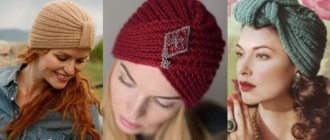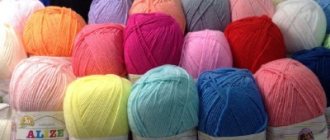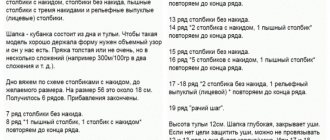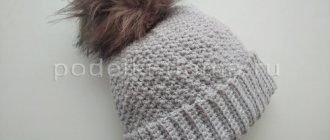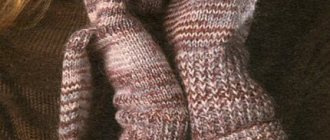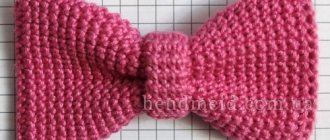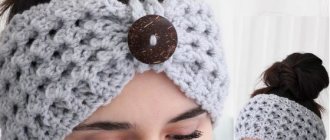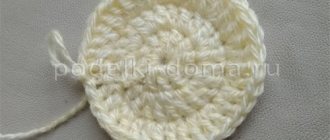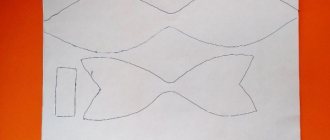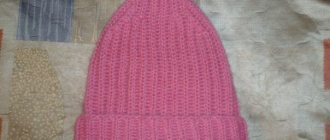Everyone's favorite mohair hats will never lose popularity. The soft, affectionate wool is pleasant to the touch, does not leave marks on the forehead and does not irritate the skin. Yes, and such products look simply amazing. There are a lot of knitting styles from these threads. We offer a selection of different patterns with a description of knitting different mohair hats.
How to knit mohair hats
Mohair is a high quality wool yarn that is fluffy, shiny and silky to the touch. For knitting, a double thread is usually used, but if you need a very warm hat, then the number of threads can be increased.
Mohair does not tolerate knitting too tightly, so when knitting at a high density, thicker knitting needles should be used . Another feature of the yarn is that it does not unravel easily. The fluffy fibers of the threads become tangled and the loops are firmly connected to each other. That is why you need to clearly monitor the correctness of knitting and not make any mistakes.
Most often, simple patterns are used - stockinette stitch, garter knitting, all kinds of elastic bands (simple, 2x2, English, semi-patent, double, figured, zigzag). A more complex knit is also suitable for a hat. It can be flat, embossed, openwork, very voluminous.
The simplest option for creating a hat involves it having a back seam: the unfolded fabric is knitted, which is then sewn along the edge with a crochet hook or a thick needle. The workflow will look like this:
Although knitting a hat allows for some variations in width, it is still better to knit a mohair sample with the selected knitting needle size and accurately calculate the density of the fabric. The resulting value must be multiplied by the head circumference (for an adult this is an average of 55 cm). The result of the calculations will determine the number of loops that need to be cast on the knitting needles. You should also consider the pattern. For example, if a simple 1x1 or English elastic band is used, then the number of loops should be a multiple of two.
When the loops are cast on, start knitting the headband. It ensures a tight fit of the product to the head and is usually done with an elastic band, the height of which can vary freely - from a couple of rows to 7-10 cm.
Some patterns can tighten the fabric (English elastic, braids, etc.). In this case, after knitting the headband, you need to pick up loops at equal intervals.
To determine their number, you should knit both the elastic and the main knitting on a sample, and then make calculations. Some hats do not have a rim. Then immediately, from the very first row, they begin to knit the pattern they like.
What sizes are needed for a hat?
The model has a good margin in terms of length. Here's how to correctly calculate how much length you need to knit. So, the model consists of two lapels. Therefore, we multiply the desired lapel in cm by 2. To this indicator we add the depth of the product and the increase per model (approximately 3-4 cm).
Around the circumference everything is simple. It is necessary to determine the head circumference using a measuring tape. For example, the result was 58.
Next, since the product is knitted from a well-stretching pattern, it is better to subtract 2 cm from the resulting number. This way the hat will hold on better and will not pull.
Examples of knitting various patterns
A knitted mohair hat is a simple product for experienced craftswomen. It is advisable for beginning needlewomen to take simple models to work with at first. As a rule, the label indicates the number of knitting needles that are suitable for the job. A fashionable item can be knitted in just a couple of days if you choose a primitive pattern and correctly calculate the number of loops.
Simple voluminous hat
To create a product, different knitting options are suitable. It is best to stick to a plastic English elastic band. In any knitting, edge loops are always knitted. Pattern diagram:
- row – alternate purl and knit stitches.
- row - front loop, throw the purl loop onto the knitting needle, without knitting, make a yarn over (thread at work), then repeat the order.
- row - the front one is thrown onto a loop, the next loop is knitted together with the yarn over, the order is repeated until the end of the row.
When knitting a product, the rapport makes up the second and third row, which is repeated until the end of the hat. If the item is without a lapel, then after 15-17 cm the loops are evenly reduced. You don’t have to remove the loops, but simply tie the edges of the fabric and pull the top together.
Seamless option
To create a seamless option, just use circular knitting needles. The peculiarity of knitting is that after the first row, the two outer loops are connected into one and the fabric continues to be knitted in a circle. When creating a product, you must take into account that you always have to work with the front side of the hat. Therefore, interesting patterns are easier to knit.
Takori with double lapel
To create a spectacular voluminous hat with a two-fold lapel, they also use an English elastic band and knit the product on circular knitting needles or crochet. In order not to miss the beginning of a new row, use a special marker - a pin. It is simply put on a knitting needle and regularly transferred to the end of the row. Knitting instructions step by step
- Row – knit stitch, yarn over (thread behind work), remove next loop unknitted.
- row - yarn over with loop is knitted one purl, yarn over (thread behind work) and the next loop is removed undone.
- row - a yarn over with a loop is knitted with one knit stitch, the yarn over (thread behind the work) and the next loop is removed undone.
To beautifully close the crown of a mohair hat with two flaps with knitting needles, the fabric is knitted only with purl and knit stitches, evenly reducing their number.
Tips for knitting a takori hat
To get started, it is better to use the Italian set. This action will help to obtain an elastic edge of the product and prevent it from tightening. To obtain it, follow the instructions below.
In conclusion, here are some general tips that may help you in your work.
- When knitting in the round, knit the loops behind the back wall of the loop . This way you will get a denser fabric;
- In order for bulky yarn, for example, mohair, to reveal all its positive qualities, it is necessary to perform an OBE of the item . In particular, mohair products are recommended to be placed in a very cold environment for some time. A freezer is quite suitable for this purpose.
- When taking measurements, do not forget to add a couple of centimeters to each measurement for a loose fit.
- To determine the required number of knitting needles, fold the thread used in several layers. Thus, the thickness of the knitting needle will be equal to the required thickness of the yarn.
Examples of knitting various patterns
Various types of hats are knitted from mohair. Most of them are some variation of a beanie (a sock cap or an elongated stocking cap).
The following are knitted according to a similar principle:
- tight-fitting option;
- model with a single lapel;
- takori (with double or triple hem);
- voluminous round hat;
- double double-sided variety;
- Trumpet hat.
The finished product can be decorated with stripes, knitted decorative elements, beads, buttons, and pompoms.
Simple voluminous hat
It is proposed to knit the option without a lapel. To work, you will need 100 g of mohair in 3 folds and knitting needles No. 6.
Step-by-step instruction:
- For example, knit a small piece of stockinette stitch, approximately 5x5 cm. Count the number of loops in 1 cm. Measure the circumference of your head. Multiply the resulting numbers.
- Cast on the needles with the calculated number of stitches, for example 50, plus a couple of stitches for the edge. Total 52 p.
- Knit 2 rows with an elastic band, alternating one knit stitch and one purl stitch.
- Start knitting the fabric with a scarf pattern: all rows, both purl and knit, consist exclusively of knit stitches, including the last one (the first, as always, is simply removed).
- Having knitted the product to a height of 25 cm, round the top by knitting all the loops of the row, except the first and last, 2 together. Now there will be 27 loops left.
- Continue knitting two stitches at a time, slipping the edge stitch and knitting the last 2 stitches of the row together. Now there are 14 of them left.
- Once again, knit two loops at a time, and pull off the remaining ones by threading the cut working thread through the bottom. Use the remaining tip to decorate the back seam in any convenient way, for example, using a needle. You need to sew the fabric from the inside out. The hat is ready.
By analogy, you can knit the fabric with another pattern you like. The main thing is not to tighten the knitting.
Seamless option
In order for the hat to not have a seam, you will have to knit in the round, therefore, there will be no edge loops here. The hat will take about 100 g of yarn in two threads. A mohair hat with English elastic is knitted like this:
The final stage of work
To give the product a finished look, you need to cut off the mohair thread, leaving a length of up to 10 cm. Open loops should be pulled together using a hook and yarn, and tie everything well. Now all that remains is to turn the hat inside out and steam it. You also need to connect the side edge loops correctly. This is done using a connecting seam.
To do this, take a regular needle with a thread that matches the color. The stitches should be made light so that the seam does not pull the hat. It should turn out elastic and soft, without losing its shape.
To knit a mohair hat, you need to have some knitting skills. Everyone can try their hand and, if desired, knit a beautiful product for themselves or their child. Such an item will be warm, fashionable and comfortable for the cold season.
Fashion trends and patterns
There are quite a few options for knitted hats. Designers offer several hats, the fashion for which has remained in recent seasons.
Hat with lapel
This is the most popular model that fits perfectly into the wardrobe of a student and a mature lady. To create, select large and small knitting. The trend is mohair hats with a lapel, knitted with a fluffy English elastic band. This is a very beautiful knitting that looks like neat rows.
Thanks to the ability to adjust the width of the lapel, a mohair hat can be considered universal. The model can be organically combined with a coat, down jacket or short fur coat. A small lapel looks more feminine; this version of the hat also fits well into a warm wardrobe.
Oversized style
Even a fashionista who has no knitting skills can create a trendy knitted hat with her own hands. The product may appear to be stretched or oversized. However, it is not. A voluminous mohair hat will give your look a charming, frivolous look. Headdresses knitted on the bias look unusual. Products made from thick threads fit perfectly into the informal style of young fashionistas. Young girls can look for things decorated with small pom-poms. Both laconic models and hats decorated with strokes of metallic paints, inscriptions or brooches are welcome.
Beanie
The model has remained in demand for many seasons. Fitted hats and elongated beanies with a lowered crown are popular. Double pieces knitted in simple stocking stitch from Italian mohair can be considered a unisex style. Hats in neutral shades (gray, black) fit stylishly into men's and women's winter wardrobes.
The elegance of a girl’s look is emphasized by products with textured decor (braids, patterns), decorated with prints, sequins, and beads. Openwork patterns combine beautifully with a knitted elastic band. Mohair beanies with pearl patterns will suit fashionistas of any age.
Berets
Even a novice craftswoman can create a fashionable beret with her own hands. It is enough to be able to knit fabric with knit/purl stitches and correctly calculate the number of loops. Experienced knitters decorate the headdress with different patterns (openwork, braids, light interlacing of stripes). Models with a small visor look interesting. It is in vain that the beret is considered an element of only the classical style. Beautiful sets of this headdress and scarf-snood are in perfect harmony with voluminous jackets, coats, and short fur coats. Products for women are knitted from mohair of any shade.
Trumpet cap
A stylish transformable headdress gives your look an unusual look. The main advantages of the model are comfort and protection from cold and piercing winds. The style of the angora hat is suitable for any style wardrobe. Openwork knitted items will emphasize the romance and femininity of the image. Things with a smooth texture, without decoration, and a tight-fitting style will fit into a sports wardrobe. Voluminous knitted hats (with braids, English elastic) will complement the winter or autumn casual style.
A set of a funnel hat and mittens or mittens looks great. It is especially comfortable in a hat, complemented by a drawstring with a cord.
White mohair - how soft!
Look at the photo: an airy women's knitted hat made of mohair, knitted with knitting needles. The description of knitting for this model is quite simple. When you knit from mohair, even a not very experienced knitter succeeds. The thread itself is so good that if you have small flaws, the yarn will hide everything. The hat consists of four braids, with a simple garter stitch between them.
Hat knitting pattern:
- Cast on 100 p., combine into a ring, knit 8 p. garter stitch (1 row knit stitch, 1 row purl stitch).
- The braid pattern tightens the knitting, so it is necessary to make additions: * 11 sts knit plaited stitches, the next 24 stitches also plaited stitches, but adding 10 stitches evenly * - repeat from * (=140 stitches). Continue with a braid pattern to a height of 22 cm.
- Forming the crown: cut 10 sts (=100 sts) on each section with braids. Then in all second r. decrease 1 point in each sector between the braids at the beginning and end of the sector from the plate.v. (=8 stitches in a row). When there are 2 stitches left in the sector, knit all stitches 2 at a time together. Then after 1 r. repeat one more time.
- Transfer the remaining loops to the working thread and pull off.
A stylish youth style for winter - this mohair hat has already been reviewed on our website TatuchkaClub.ru, we will not repeat it. Follow the link under the photo to see the diagram and description of knitting a hat on knitting needles.
Description here
Set of loops
Casting with open loops does not tighten the fabric and allows you to make a more accurate seam at the end of the work.
I will need 2 pairs of knitting needles of the same size: working needles can be straight or circular, additional ones should be circular.
- I unwind the thread a little less than a meter and throw it on a working knitting needle (RS), as shown in the photo. I lower the free end lower, the loops on the PC will be cast on from it. And I raise the thread coming from the skein higher - it is used to cast on loops on an additional knitting needle (DS).
- I put the DS under the RS on top of the yarn. I wrap the thread from the skein around the DS in the direction from bottom to top and away from me. I take it out to RS and tighten it. Cast on 1 loop.
- I bring the loose thread forward between the knitting needles, wrap the RS from the bottom up and lower it behind the work.
- I type in the same way as point 2.
I continue casting on points 3 and 4 until I reach 40 main and additional loops. On the reverse side, the interlacing of threads resembles purl stitch.
Then I move the loops on the DS to the middle of the fishing line; I won’t need them until the end of the work. To prevent the cast-on edge from unraveling, I wrap the folded end of the thread around the one that comes from the skein, tighten it slightly and release it.
Mohair beanie hat
Knitted fashion in recent years involves simple patterns combined with flowing silhouettes. This also applies to hats. The next hat model is also knitted from soft fluffy threads with mohair in a beanie style. The next style in our selection of mohair hats is a hat with a simple pattern from Drops, called Jacinta. Sizes: 56-57 cm and 57-58 cm.
You will need: - Drops Kid Silk yarn (75% mohair, 25% silk, 200m/25g); - circular knitting needles No. 3 and No. 2.5. Density: 24 p. = 10 cm
How to knit a mohair beanie hat?
- Cast on knitting needles No. 2.5 with double thread 136/144 sts and knit 1 r. knit stitch, then 4 cm ribbing pattern 2 x 2 (k2, p2).
- Change tool to No. 3 and continue knitting with one thread. Tie 1 p. persons.p., while being equal. decreasing 22/24 p. (=114/120 p.) and continue with the pattern according to the pattern 18 cm long.
- Next, knit 1 p. knits.p., decreasing 14/10 p. (= 100/110 p.).
- Place 10 markers every 10/11 stitches and continue further in garter stitch (k1, p1). In all second rows, decrease 1 stitch in front of the markers. When there are 20/30 stitches on the knitting needles, knit all the loops 2 together (=10/15 stitches).
- Transfer the remaining loops to the working thread, pull and fasten.
Scarf: description here
Knitting pattern for a mohair hat Hyacinth.
How much yarn is needed for a hat?
Of course, each master can count the amount of yarn based on his individual knitting characteristics.
But there are also general average statistical calculations. The amount of yarn per hat is approximately 100 to 200 g.
- Women's model size 38 - from 150 g.
- Men's model size 50 - 150–200 g.
- Children's model size 30 - from 100 g.
These data are taken taking into account knitting a hat without making decorative elements. Many craftsmen also like to decorate their products with additional knitted decor. So, knitted flowers look impressive on hats. In this case, the volume of threads increases.
Delicate openwork
We offer a new knitted mohair hat from the design studio Drops, consisting of a delicate openwork hat and a garter stitch snood.
The set is called “Lavender Sky”. Sizes: 54-56 cm and 56-58 cm, cap length 25-27 cm. Consumption: 75 grams For knitting you will need: - Drops Kid Silk strands (75% mohair, 25% silk, 200m/25g); - knitting needles on fishing line No. 3.5 and No. 2.5. Density: 23 p. = 10 cm For the openwork pattern, see diagrams A1 to A3, where all rows are indicated. How to knit an openwork mohair hat with knitting needles?
- Using a thread in two folds using knitting needles No. 2.5, cast on 124/132 sts and knit 1 p. purl (= wrong side) rows “back and forth”. Next, continue with a 2x2 rib (k2, p2) 4-5 cm high.
- Change the knitting needles to No. 3.5, remove one thread and knit 1 r. knits.p., at the same time evenly decreasing 17 p. (= 107/115 p.). Then another 1 rub. facial
- Next, distribute the loops like this: edge stitch, 8 stitches according to pattern A1, then all loops according to pattern A2, except the last 10 stitches, then 9 stitches according to pattern A3, edge stitch. Knit this way until the height of the hat is 18/19 cm (the rapport by that time should be either half or fully knitted).
- 1 row of knits.p. on the front side, decreasing 17/15 p. (=90/100 p.). Divide the knitting into sections of 9-10 stitches and mark them with 10 markers, continue with a garter stitch pattern (all stitches knit). Start making decreases every 4th row, knitting 2 stitches together after all markers (=80/90 stitches)
- When 10 stitches remain, knit them 2 together. (=5p.). Transfer them to the working thread and pull them off. Carefully sew the seam.
- For snood, on circular needles No. 4, cast on 148/168 stitches with thread in two folds (for a tight edge), then remove one thread and continue in one fold with garter stitch to a height of 35/40 cm.
Knitting pattern for the Lavender Sky hat.
Mohair hat with lapel with description
Mohair hats with a lapel, knitted on knitting needles, are extremely popular. Such headdresses are also called Takori. They are knitted with one lapel or two. The description and knitting pattern are absolutely the same. The only difference is the length. With one lapel, knit a height of 27-33 cm, with two - up to 35-38 cm, depending on how wide the lapel is planned.
You will need: – Nako yarn (40% mohair, 60% acrylic, 100gr/500met) – 100 grams; - knitting needles No. 5. You can knit a hat with either straight or circular knitting needles, whichever is more convenient for you. On circular knitting needles the product will turn out more neat without a seam. Head volume: 54-56 cm English elastic band (even number of stitches): 1 p.: * 1 knit, 1 p. double crochet * - repeat from * to the end of the p. 2p.: * knit a loop with a double crochet, remove the next one with a double crochet *
Hat knitting pattern:
- Cast on 64 stitches with two folds of thread and knit with an English elastic band 28-30 cm.
- Now we need to make some reductions. To do this: * knit 3 stitches together purlwise (grab the purl, knit and purl in a row), 5 stitches according to the pattern * - repeat from *. Make such decreases every 4th row, reducing the distance between decreases by 2 sts.
- When there are 12-15 stitches left on the knitting needles, transfer them to the working thread and pull them off. Firmly tighten and pull the tip inward.
Knitted winter hats, the work of our readers
Spectacular winter hat knitted
A spectacular winter hat for a girl or girl! An excellent option for the currently fashionable family look format!!! Knitted with knitting needles, I used DIAMOND thread (wool + acrylic). Knitting needles - for elastic band No. 2, for the main pattern No. 3. You can knit without a seam, on
Read more…
Description of a winter hat with knitting needles made of thick yarn
Hats made of thick yarn. The yarn was used from the Pekhori factory “Souvenirnaya”. 160 meters per 200 grams. 50% wool 50% acrylic. The hats turned out dense, but at the same time soft. After washing they remained unchanged. My daughter wears one all the time. A cap
Read more…
Knitted winter hat for a girl – Tatiana’s work
Winter hat for a 1.5 year old girl made from leftover yarn. To knit this hat, I used leftover yarn, knitted it with double thread, it turned out to be a very warm and bright hat, my daughter really likes it. We measure the head circumference, determine the knitting density by knitting a small
Read more…
Winter helmet
Hello, my name is Natalya. I live in the Altai region. Our winters are harsh, so we have to imagine how to make a warm and at the same time beautiful hat for a child. For several winters now my child has been wearing helmets, this
Read more…
Knitted winter hat with ears
The work was submitted to our competition “Hats and Sets”. Author Master Svetlana. I needed: 200 g of 100% Turkish wool “BRAVO”, acrylic and circular knitting needles 40 cm long. In order to determine the knitting density, you need to knit a sample
Read more…
Women's winter hat from Tatyana Vaganova
Hat with a pattern of Royal braids. Knitted from Magnificent Pekhorka Winter yarn, 100g/300m, knitting needles No. 3 and 3.5. I dialed 122p on sleeper number 3. and the elastic band 1*1 22 rows went. I made one purl row for the fold, then
Read more…
Double-sided winter men's hat knitted
I decided to knit a hat for my dad. I found a model that would suit both of us - he prefers hats with a lapel, but I wanted aranami. The photo of the model was accompanied by a VERY INTERESTING description. The whole relish, so to speak, is that
Read more…
Knitted children's hat “Pearl Winter”
The author of this hat is Sasha’s Mom from Osinka. Since the hat is specifically for winter, it should be as warm as possible, so Sasha’s Mom chose this kind of wicker - dense and dense, but in principle you can take any other one. Loops
Read more…
Knitted children's winter hat
For a long time I was looking for a hat model on the Internet to knit a neat winter hat for a 3-year-old child with a pom-pom and ears, and I found... It’s called “I HEART CABLES”. Looks very nice on children, even boys, even
Read more…
What will you need at work?
To knit a hat with knitting needles using English elastic according to the takkori pattern, you will need the most ordinary threads and knitting needles. Here is an approximate set of tools and materials that need to be prepared:
- wool yarn, approximately 200-250 meters thick per 100 grams;
- stocking or circular knitting needles No. 4-5;
- tape measure;
- scissors.
Angora or mohair takori can be knitted with 2-ply thread, as these are quite thin threads. It is better if the yarn contains not only 100% wool - fibers woven with acrylic are much stronger and more durable.
Note! English rib knitting is quite fluffy, and it requires 1.5 times more threads than when creating other patterns with knitting needles. This is important to consider when purchasing threads and making calculations.
The photo shows how fluffy and soft knitted takori are.
